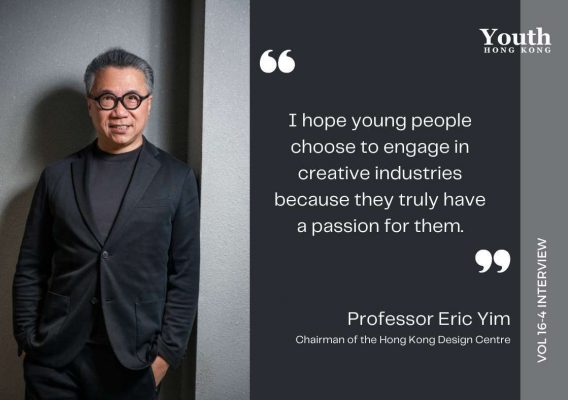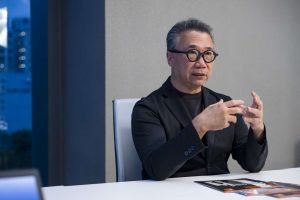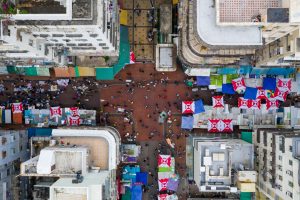//16.4 Interview: Professor Eric Yim
Professor Eric Yim talks about recent developments in Hong Kong’s creative industries, its global position as a creative hub, and the power of design thinking.
Creativity is more than a burst of inspiration. It’s a way of thinking, problem-solving and connecting with people. For Professor Eric Yim, an architect-turned-furniture designer, Chairman of the Hong Kong Design Centre and Professor at the Hong Kong Polytechnic University, creativity is not just about imagining the new but about making it practical and impactful through design thinking.
In this interview, he shares how design thinking solves real-world problems in business, education, and even city planning. He also reflects on Hong Kong’s potential as a creative hub, how to nurture talented youth and give them opportunities to unleash creativity.
Think How They Think
Professor Yim’s career started with his furniture company – Posh Office Systems. Having studied architecture at the University of Cambridge, Professor Eric Yim turned to furniture design upon returning to Hong Kong. With no prior business experience, he had no grand ambitions but to design high-quality furniture for clients. Later, the company successfully expanded from a locally-based SME into a global brand.
“I didn’t know anything about doing business, but gradually I figured it out by applying design thinking to solve problems in business operations, from marketing and manufacturing to distribution,” Professor Yim tells Youth Hong Kong. With a designer background, he ponders how he became a businessman, industrialist and entrepreneur by leveraging what he learns.
Specifically, he emphasises the involvement of all stakeholders throughout the business cycle, including end users, facility managers, administrative personnel and purchasing managers. To optimise his business model and service, he always considers the needs of these groups who do not only evaluate aesthetic value.
“They’re considering factors including packaging, logistics, storage and inventory management,” he explains. “Design thinking is about empathy. If we could think how they think, we could address their concerns effectively.”
This philosophy extends beyond products. Professor Yim sees design thinking as a tool for tackling broad social issues, such as city planning, community engagement and public policies, believing that the mindset of asking “why” before trying to solve problems applies universally. “Take traffic jams, for example. Instead of focusing on quick fixes, we should first identify root causes and then develop targeted solutions,” he says.
Creativity v.s. Design Thinking
Design thinking for Professor Yim involves a human-centred approach and thinking tools that use innovative ways to solve a problem, and this is where creativity comes in. However, he notes that while everyone can be creative, not everyone is capable of the most important thing – bringing ideas into practice through design thinking. Without this methodology, he says ideas are like the blue-sky thinking of a three-year-old child. “We encourage creativity, but innovation is something we should encourage even more.”
Is Hong Kong a creative or innovative city? The answer is not always positive. In the latest World Intellectual Property Organization (WIPO) global innovation index, a measure of the level of innovation in a society, Hong Kong’s ranking has fallen from the 8th in 2021 to 18th in 2024. The decline signifies the broader challenges the city face in maintaining its competitive edge in innovation and technology.
To encourage creativity and design thinking, Professor Yim says education must be a cornerstone of innovation. He believes that the education system should not repress creative ideas by imposing excessive rules and restrictions. “Why do students have to raise their hands when they have questions to ask?” He questions whether such rules and restrictions in schools and workplaces stifle creativity.
We once thought we should follow the paths laid out by our parents… However, times have changed, and the context today is entirely different.
Another mindset he believes in is that educators should embrace open-mindedness and foster an environment where young people can learn from their failures. “We once thought we should follow the paths laid out by our parents, who, out of love and concern, worried about us straying onto the wrong course. However, times have changed, and the context today is entirely different,” he notes. He questions whether traditional educational methods still resonate with young people growing up in a world vastly different from that of their parents.
Reflecting on his own entrepreneurial journey, Professor Yim thinks it is important to give young people more independence and opportunities to learn, even from failure. “I too have made wrong decisions, but they were not important. What matters is that I learned from the process and that outweighs the outcome.”
Hong Kong as a Creative Hub
The creative environment in Hong Kong, according to Professor Yim, is full of potential. As one of the world’s dynamic creative hubs, Hong Kong shares some features of cities like New York and London when it comes to the transition from manufacturing to service industries. The inclusiveness and cultural diversity of a city, he believes, also contribute to its creative culture.
The dynamics of economic development and the creative economy can be proved by Richard Florida’s Creative Capital Theory, articulated in his 2002 book, The Rise of the Creative Class. One of Florida’s central findings is that creative individuals tend to cluster in specific geographic areas that are more likely to experience economic prosperity. In turn, regions with a high concentration of creative professionals often generate high-end jobs and foster economic growth.
New York and London are well-known global cultural capitals. While New York boasts a diverse creative economy that includes fashion, film, music and the visual arts, London is known for advertising, design and the performing arts. Professor Yim believes Hong Kong is following in the footsteps of such cities and is on its way to becoming another creative capital.
He also comments on Hong Kong’s transition from a manufacturing centre to a centre for research and development, marketing, distribution and other knowledge-based services. He says products “made in Hong Kong” are only a small part of the industry chain, while the term “made by Hong Kong” represents diverse products that are researched, developed, designed, or produced in the city. “If we put the emphasis only on the manufacturing side, we miss out other important components of the industry chain.”
Although Hong Kong’s cultural and creative industries accounted for only 4.5% of GDP in 2022, he notes that their actual contribution to Hong Kong’s economy is greater than it looks in official data because the scale of employment opportunities make the real contribution hard to measure.
Give Young People a Free Hand
Professor Yim’s vision for the future centres on empowering youth. “I hope young people choose to engage in creative industries because they truly have a passion for them, not just because they have no other options. Most importantly, they must first recognise the power and value of design.”
Furthermore, he says that design is not just about making beautiful products and young people should break free of pre-existing perceptions and understanding of the subject. “Everything is about design. We go to a museum to appreciate the design of our ancestors. Design serves as a reflection of our civilisation,” he says. “Without designers, it’s likely that human civilisation could experience stagnation in both creativity and progress.”
To conclude, Professor Yim hopes society will give young people more opportunities and a “free hand” to try, adding that the methods that were successful in the past may not necessarily work now. “Young people need to chart their own paths. Their understanding and sensitivity to the world may be better than that of our generation, so we shouldn’t always impose our ideas on them,“ he concludes. ■






